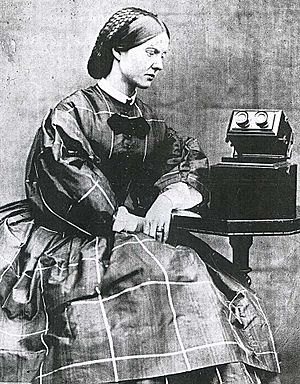Mary Ward (scientist) facts for kids
Quick facts for kids
Mary Ward
|
|
|---|---|

photograph of Mary Ward
|
|
| Born |
Mary King
27 April 1827 Ballylin, County Offaly, Ireland
|
| Died | 31 August 1869 (aged 42) Parsonstown (current day Birr), County Offaly, Ireland
|
| Cause of death | accident with a steam-powered car |
| Resting place | Parsons Family Vault, Old St Brendan’s Church, Birr, County Offaly, Ireland |
| Other names |
|
| Known for |
|
| Spouse(s) | Henry Ward, 5th Viscount Bangor (m. 1854) |
| Children | 8, including Maxwell Ward, 6th Viscount Bangor |
| Relatives | William Parsons, 3rd Earl of Rosse (cousin) |
| Scientific career | |
| Fields | astronomy, entomology, microscopy |
| Patrons | Sir David Brewster, for whom she was an assistant and illustrator |
Mary Ward (born Mary King; 27 April 1827 – 31 August 1869) was an amazing Irish scientist. She loved studying nature, stars, and tiny things you can only see with a microscope. Mary was also a talented writer and artist. She is known for being the first person to write a book about microscopes. Sadly, she was also the first person known to have died in an accident involving a motor vehicle.
Contents
Early Life and Learning
Mary King was born on April 27, 1827, in Ballylin, near Ferbane, County Offaly, Ireland. She was the youngest child of Henry and Harriette King. Like many girls at that time, Mary and her sisters learned at home from a teacher. However, Mary's family was very interested in science. This meant her education was a bit special. From a young age, Mary loved nature. By the time she was three, she was already collecting insects!
Discovering the World
Exploring the Stars
Mary Ward loved looking at the night sky. She shared this hobby with her cousin, William Parsons, 3rd Earl of Rosse. William was a famous scientist who built a giant telescope. It was called the "Leviathan of Parsonstown". This telescope had a huge six-foot mirror. It was the biggest telescope in the world for many years! Mary often visited William's home, Birr Castle. She drew pictures of the telescope as it was being built. Her drawings, along with photos taken by William's wife, Mary Rosse, helped restore the telescope later on.
A Tiny World Up Close
Mary also enjoyed drawing insects. One day, a famous astronomer named James South saw her drawing. She was using a magnifying glass to see the small details. He was so impressed by her drawings that he convinced her father to buy her a microscope. This special microscope cost a lot of money back then. It started Mary's lifelong passion for tiny things. She read every book she could find about microscopy. She taught herself until she became an expert. Mary even made her own slides for the microscope. She used thin pieces of ivory because glass was hard to get. Sir David Brewster, a famous physicist, asked Mary to prepare specimens for his microscope. He also used her amazing drawings in many of his books.
Breaking Barriers in Science
In Mary's time, universities and most science groups did not accept women. But Mary found ways to learn. She often wrote to scientists, asking about their research papers. Her cousin, William Parsons, became the president of the Royal Society in 1848. When Mary visited his home in London, she met many important scientists. She was one of only three women on the mailing list for the Royal Astronomical Society. The other two were Queen Victoria and Mary Somerville, another famous scientist.
Family Life
On December 6, 1854, Mary married Henry Ward. He later became Viscount Bangor. They had eight children together: three sons and five daughters. One of their sons was Maxwell Ward, 6th Viscount Bangor. Mary's great-granddaughter, Lalla Ward, later became a well-known actress.
Sharing Discoveries with Books
Mary Ward wrote her first book, Sketches with the Microscope, in 1857. She thought no one would publish it because she was a woman and didn't have a university degree. So, she printed 250 copies herself. She also handed out flyers to tell people about it. All the copies sold quickly! This encouraged a publisher in London to print her book. It was reprinted eight times between 1858 and 1880. The book was renamed A World of Wonders Revealed by the Microscope. In September 2019, a new colorful edition of her book was published.
Mary wrote several other books too. These included A Windfall for the Microscope (1856) and Telescope Teachings (1859). She drew all the pictures for her own books and for many other scientists' works.
A Tragic Accident
Mary Ward is known as the first person to die in an accident involving a motor vehicle. In 1869, her cousin William Parsons' sons built an experimental steam car. On August 31, 1869, Mary was riding in this car. Her husband, Henry, and the Parsons boys were also with her. As the car went around a bend in the road, Mary was accidentally thrown from it. She died almost immediately from her injuries. It is believed that her family, saddened by the accident, later destroyed the car.
Legacy
Today, you can see Mary Ward's microscope, accessories, slides, and books. They are on display at her husband's home, Castle Ward, in County Down. William Parsons' home, Birr Castle, in County Offaly, is also open to the public. Mary Ward's work helped many people learn about the tiny world of microscopy and the vastness of space.
See also
 In Spanish: Mary Ward (científica) para niños
In Spanish: Mary Ward (científica) para niños
- Bridget Driscoll
- Henry H. Bliss

